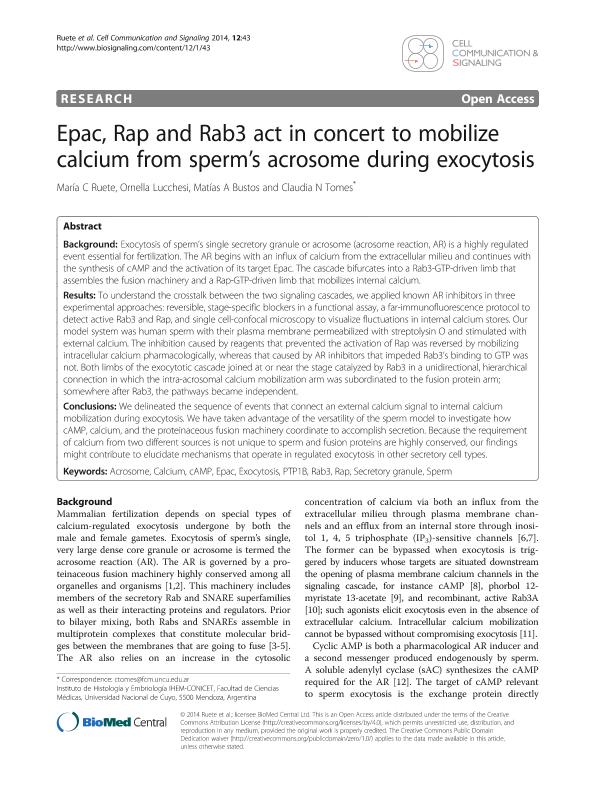Mostrar el registro sencillo del ítem
dc.contributor.author
Ruete, María Celeste

dc.contributor.author
Lucchesi, Ornella

dc.contributor.author
Bustos, Matias Alberto

dc.contributor.author
Tomes, Claudia Nora

dc.date.available
2018-01-02T21:08:08Z
dc.date.issued
2014-08
dc.identifier.citation
Tomes, Claudia Nora; Bustos, Matias Alberto; Lucchesi, Ornella; Ruete, María Celeste; Epac, Rap and Rab3 act in concert to mobilize calcium from sperm's acrosome during exocytosis; BioMed Central; Cell Communication and Signaling; 12; 43; 8-2014; 1-16
dc.identifier.issn
1478-811X
dc.identifier.uri
http://hdl.handle.net/11336/32065
dc.description.abstract
BACKGROUND: Exocytosis of sperm's single secretory granule or acrosome (acrosome reaction, AR) is a highly regulated event essential for fertilization. The AR begins with an influx of calcium from the extracellular milieu and continues with the synthesis of cAMP and the activation of its target Epac. The cascade bifurcates into a Rab3-GTP-driven limb that assembles the fusion machinery and a Rap-GTP-driven limb that mobilizes internal calcium.
RESULTS: To understand the crosstalk between the two signaling cascades, we applied known AR inhibitors in three experimental approaches: reversible, stage-specific blockers in a functional assay, a far-immunofluorescence protocol to detect active Rab3 and Rap, and single cell-confocal microscopy to visualize fluctuations in internal calcium stores. Our model system was human sperm with their plasma membrane permeabilized with streptolysin O and stimulated with external calcium. The inhibition caused by reagents that prevented the activation of Rap was reversed by mobilizing intracellular calcium pharmacologically, whereas that caused by AR inhibitors that impeded Rab3's binding to GTP was not. Both limbs of the exocytotic cascade joined at or near the stage catalyzed by Rab3 in a unidirectional, hierarchical connection in which the intra-acrosomal calcium mobilization arm was subordinated to the fusion protein arm; somewhere after Rab3, the pathways became independent.
CONCLUSIONS: We delineated the sequence of events that connect an external calcium signal to internal calcium mobilization during exocytosis. We have taken advantage of the versatility of the sperm model to investigate how cAMP, calcium, and the proteinaceous fusion machinery coordinate to accomplish secretion. Because the requirement of calcium from two different sources is not unique to sperm and fusion proteins are highly conserved, our findings might contribute to elucidate mechanisms that operate in regulated exocytosis in other secretory cell types.
dc.format
application/pdf
dc.language.iso
eng
dc.publisher
BioMed Central

dc.rights
info:eu-repo/semantics/openAccess
dc.rights.uri
https://creativecommons.org/licenses/by/2.5/ar/
dc.subject
Epac
dc.subject
Rab3
dc.subject
Rap
dc.subject
Calcium
dc.subject
Acrosome
dc.subject
Sperm
dc.subject
Camp
dc.subject
Exocytosis
dc.subject
Secretory Granule
dc.subject
Ptp1b
dc.subject.classification
Otras Ciencias Biológicas

dc.subject.classification
Ciencias Biológicas

dc.subject.classification
CIENCIAS NATURALES Y EXACTAS

dc.title
Epac, Rap and Rab3 act in concert to mobilize calcium from sperm's acrosome during exocytosis
dc.type
info:eu-repo/semantics/article
dc.type
info:ar-repo/semantics/artículo
dc.type
info:eu-repo/semantics/publishedVersion
dc.date.updated
2017-12-29T14:11:21Z
dc.journal.volume
12
dc.journal.number
43
dc.journal.pagination
1-16
dc.journal.pais
Reino Unido

dc.journal.ciudad
Londres
dc.description.fil
Fil: Ruete, María Celeste. Consejo Nacional de Investigaciones Científicas y Técnicas. Centro Científico Tecnológico Conicet - Mendoza. Instituto de Histología y Embriología de Mendoza Dr. Mario H. Burgos. Universidad Nacional de Cuyo. Facultad de Cienicas Médicas. Instituto de Histología y Embriología de Mendoza Dr. Mario H. Burgos; Argentina
dc.description.fil
Fil: Lucchesi, Ornella. Consejo Nacional de Investigaciones Científicas y Técnicas. Centro Científico Tecnológico Conicet - Mendoza. Instituto de Histología y Embriología de Mendoza Dr. Mario H. Burgos. Universidad Nacional de Cuyo. Facultad de Cienicas Médicas. Instituto de Histología y Embriología de Mendoza Dr. Mario H. Burgos; Argentina
dc.description.fil
Fil: Bustos, Matias Alberto. Consejo Nacional de Investigaciones Científicas y Técnicas. Centro Científico Tecnológico Conicet - Mendoza. Instituto de Histología y Embriología de Mendoza Dr. Mario H. Burgos. Universidad Nacional de Cuyo. Facultad de Cienicas Médicas. Instituto de Histología y Embriología de Mendoza Dr. Mario H. Burgos; Argentina
dc.description.fil
Fil: Tomes, Claudia Nora. Consejo Nacional de Investigaciones Científicas y Técnicas. Centro Científico Tecnológico Conicet - Mendoza. Instituto de Histología y Embriología de Mendoza Dr. Mario H. Burgos. Universidad Nacional de Cuyo. Facultad de Cienicas Médicas. Instituto de Histología y Embriología de Mendoza Dr. Mario H. Burgos; Argentina
dc.journal.title
Cell Communication and Signaling

dc.relation.alternativeid
info:eu-repo/semantics/altIdentifier/doi/http://dx.doi.org/10.1186/s12964-014-0043-0
dc.relation.alternativeid
info:eu-repo/semantics/altIdentifier/url/https://biosignaling.biomedcentral.com/articles/10.1186/s12964-014-0043-0
Archivos asociados
